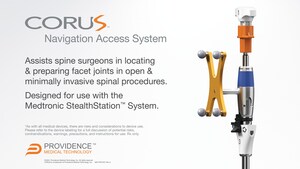Providence Medical Technology Announces Publication of Two New Studies Supporting Tissue-Sparing Posterior Cervical Fusion
WALNUT CREEK, Calif., July 10, 2017 /PRNewswire/ -- Providence Medical Technology, Inc., a developer of innovative cervical spine technology, announced the publication of multiple independent studies demonstrating the results of its tissue-sparing posterior cervical fusion technology.
In the first study published by Lenzi J, et al. in World Neurosurgery (2017), the authors report results from the first ever prospective, randomized, controlled trial comparing operative results using the DTRAX® Expandable Cage system versus conservative care for patients diagnosed with single-level cervical radiculopathy. The study presents data on 40 patients from each group. The paper reports significant improvements in VAS neck and arm pain relative to the control group at all time points out to one year. The paper also reports marked improvements from baseline in NDI and SF-36. This publication was completed independent of any conflict of interest from the authors and not sponsored in any way by the company. The table below summarizes the VAS results.
| Pre |
1 Month |
6 Months |
12 Months |
|
| Surgery |
||||
| VAS neck |
5.725 |
1.925 |
0.75 |
0.33 |
| VAS arm |
8.65 |
0.575 |
0.35 |
0.25 |
| Conservative Care |
||||
| VAS neck |
5.475 |
3.8 |
1.5 |
1.05 |
| VAS arm |
8.775 |
5.35 |
3.615 |
1.77 |
A complete copy of this study can be found at http://dx.doi.org/10.1016/j.wneu.2016.12.125
In the second publication by William Smith, et al. in Operative Neurosurgery (2017), the authors report the results of bilateral posterior cervical fusion cages for the treatment of anterior cervical pseudarthrosis again through the use of the company's flagship tissue-sparing DTRAX Spinal System and CAVUX® Cervical Cages. This study was not sponsored by Providence in any way; however, some of the investigators and authors of this publication maintain ownership and compensation relationships with Providence. This paper reports results of 25 patients at a mean follow-up of 18 months. The table below summarizes improvements in VAS neck, VAS arm, and NDI scores. This study also reports that fusion was confirmed radiographically in all 25 patients.
| Pre-Op |
Follow-up |
|
| VAS neck |
7.9 |
3.8 |
| VAS arm |
7.24 |
3.12 |
| NDI |
65.1 |
29.1 |
A complete copy of this study can be found at http://doi.org/10.1093/ons/opx103
"We were delighted to receive notification of these recent publications adding to the growing body of clinical evidence supporting our innovative tissue-sparing posterior cervical fusion technology," said Jeff Smith, CEO of Providence. "We are grateful for the work of these authors and particularly thankful to the patients who volunteered to participate in a randomized controlled trial to study the impact of our novel surgical approach. These independent studies represent two of the more common applications of our cervical fusion technology, and it is encouraging that new clinical evidence continues to support these use cases. We are committed to clinical research and look forward to additional publications moving forward."
The DTRAX Expandable Cage System used in the first study is CE marked and indicated for posterior cervical treatment at C3-C7 (inclusive) spinal levels for the following: patient with single level radiculopathy due to degenerative disc disease (DDD) as defined by back pain of discogenic origin with degeneration of the disc confirmed by history and radiographic studies and/or degenerative disease of the facets. The DTRAX Expandable Cage System used in the first study is not cleared or approved by the FDA and is not available for order or sale in the United States.
The CAVUX Cervical Cage system used in the second study is CE marked and FDA cleared and indicated for use in skeletally mature patients, with degenerative disc disease (DDD) of the cervical spine (C3-C7) with accompanying radicular symptoms at one disc level. DDD is defined as discogenic pain with degeneration of the disc confirmed by patient history and radiographic studies. Patients should have received at least size weeks of non-operative treatment prior to treatment with the device. Devices are intended to be used with autogenous bone graft and supplemental fixation, such as an anterior plating system.
About Providence Medical Technology, Inc.
Providence Medical Technology, Inc. is a privately-held medical device company focused on innovative solutions for cervical spinal conditions. The company has pioneered a proprietary, tissue-sparing approach to posterior cervical fusion. Providence has developed surgical instrumentation and implants that offer unique benefits to the $2 billion worldwide cervical spine market. The Providence family of products includes the DTRAX® Spinal Instrumentation System, CAVUX® intervertebral implants, and the ALLY™ line of bone and facet screws. All products are shipped-sterile and single-use to maximize perioperative efficiency and ensure consistent quality and performance. For more information, visit www.providencemt.com
For other clinical publications regarding this technology visit www.providencemt.com/clinical
SOURCE Providence Medical Technology, Inc.
Related Links
WANT YOUR COMPANY'S NEWS FEATURED ON PRNEWSWIRE.COM?
Newsrooms &
Influencers
Digital Media
Outlets
Journalists
Opted In






Share this article